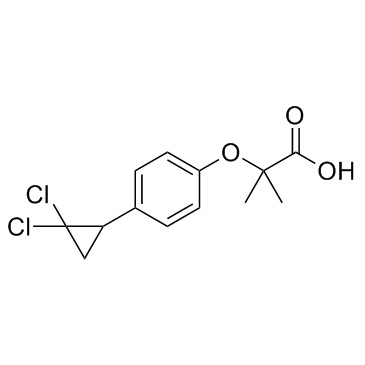Ciprofibrate, clofibric acid and respective glycinate derivatives. Effects of a four-week treatment on male lean and obese Zucker rats.
Amelie Lupp, Elke Karge, Thomas Deufel, Herbert Oelschlägers, Christian Fleck
Index: Arzneimittelforschung 58(5) , 225-41, (2008)
Full Text: HTML
Abstract
Fibrates are widely prescribed in hyperlpidemic patients to prevent atherosclerosis. Their therapeutic use, however, can be associated with adverse effects like gastrointestinal disorders, myalgia, myositis and hepatotoxicity. In rodents large doses can even cause hepatocellular carcinoma. Additionally, interactions with the biotransformation of other compounds at the cytochrome P450 (CYP) system have been observed. Thus, the discovery of new substances or derivatives with less side effects is of great interest. In the present study the influence of a four-week daily oral administration of 2 mg/kg body weight ciprofibrate (CAS 52214-84-3) or of 100 mg/kg body weight clofibric acid (CAS 882-09-7) was compared to that of the respective doses of their newly synthesized glycine conjugates in adult male lean and obese Zucker rats. Although obese rats displayed distinctly higher serum lipid concentrations, after fibrate treatment values were significantly lowered in lean animals only. Livers of obese rats were significantly enlarged, histologically showing a fine-droplet like fatty degeneration and an increase in glycogen content, but no signs of inflammation. After fibrate administration histologically a hypertrophy, an eosinophilia, a reduced glycogen content and also hepatocyteapoptosis were observed. Livers of obese rats displayed higher CYP1A1 andCYP2E1 expression, but lower immunostaining for CYP2B1 and CYP3A2. No differences between the two groups of rats were seen with respect to CYP4A1 expression. Due to fibrate treatment especially CYP2E1 and CYP4A1, but also CYP1A1, 2B1 and 3A2 were induced. Resulting CYP mediated monooxygenase activities were also elevated in most cases. In general, effects of clofibric acid and clofibric acid glycinate (CAS 4896-55-3) were less distinct than those of ciprofibrate and its glycinate (CAS 640772-36-7). With no parameterinvestigated major differences were seen between the parent fibrates and their glycine conjugates. Thus, the present investigations revealed no noticeable advantages of the glycinates over ciprofibrate or clofibric acid.
Related Compounds
| Structure | Name/CAS No. | Molecular Formula | Articles |
|---|---|---|---|
 |
Ciprofibrate
CAS:52214-84-3 |
C13H14Cl2O3 |
|
Transcriptional Regulation of Cytosolic Sulfotransferase 1C2...
2015-12-01 [J. Pharmacol. Exp. Ther. 355 , 429-41, (2015)] |
|
Ciprofibrate increases cholesteryl ester transfer protein ge...
2009-01-01 [Lipids Health Dis. 8 , 50, (2009)] |
|
Differential regulation of peroxisome proliferator-activated...
2009-03-01 [Endocrinology 150(3) , 1192-201, (2009)] |
|
Species-specific kinetics and zonation of hepatic DNA synthe...
2008-07-01 [Toxicol. Sci. 104(1) , 74-85, (2008)] |
|
The atherogenic role of triglycerides and small, dense low d...
1996-07-01 [Atherosclerosis 124 Suppl , S21-8, (1996)] |